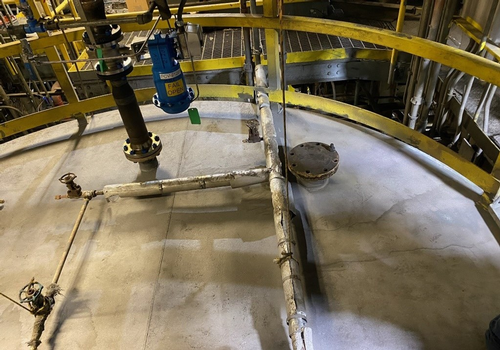FRIDAY, DECEMBER 1, 2023
International industrial protective coatings and composites manufacturer Belzona recently announced that it was chosen to provide thermal insulation coatings to one metal tank at a lubricant plant for a leading oil and gas company.
According to the company’s release, Belzona 5871, a two-component, polymeric, solvent free system for thermal insulation and corrosion protection, was chosen to lower the surface temperature of the tank to prevent burns and halt further corrosion.
About the Project
Belzona stated that the upper surface of the tank, which reaches a temperature of 230 degrees Fahrenheit, currently serves as a walkway for operators, creating a risk to employees of receiving contact burns from the hot substrate. Additionally, some pitting corrosion had reportedly occurred on the tank.
According to the guidance set forth by the U.S. Department of Labor’s Occupational Safety and Health Administration, the maximum temperature for exposed surfaces that an employee can encounter is 140 F, aligning with ASTM C1055.

 |
| Photos: Belzona |
|
International industrial protective coatings and composites manufacturer Belzona recently announced that it was chosen to provide thermal insulation coatings to one metal tank at a lubricant plant for a leading oil and gas company. |
Additionally, other rules require workers to be protected from exposed heated surfaces, making it important to lower the surface temperature of this tank to remove the potential for any hazard. The metal tank surface had reportedly begun to show signs of pitting corrosion, creating a need for pit filling and a protective coating to prevent it from corroding further.
In addition to stopping contact-burn injuries, Belzona stated that its thermal insulation product only needs two coats to allow for a quick turnaround time, while also offering corrosion resistance.
The surface was reportedly prepped by vapor blasting the substrate to meet SSPC-SP 10/NACE No. 2 (Near-White Metal) standards and was then degreased. On top of this, corrosion at the top of the tank that needed pit filling was repaired with Belzona 1121 (Super XL-Metal) before the new coating was applied.
 |
|
According to the guidance set forth by the U.S. Department of Labor’s Occupational Safety and Health Administration, the maximum temperature for exposed surfaces that an employee can encounter is 140 degrees F, aligning with ASTM C1055. |
With the surface prepared, the first coat of Belzona 5871 was applied with a short-bristled brush, reportedly expanding to help reduce the number of layers needed.
According to the release, the first coat was applied at the target thickness of 1000 µm (39 mil) wet film thickness, resulting in 3000 µm (118 mil) dry film thickness. The second coat was reportedly applied using the same method six hours later.
Belzona states that the tank was back to full service 12 hours after the final coat was applied and that the tank’s temperature was successfully reduced from 230 F to 140 F.
Tagged categories: Belzona; Case History; Certifications and standards; Coating Application; Coating Materials; Corrosion; Corrosion protection; Corrosion resistance; Department of Labor; Health & Safety; Health and safety; Insulating coatings; Insulation; Oil and Gas; OSHA; OSHA; Safety; Tanks; Thermal-barrier coatings; Workers